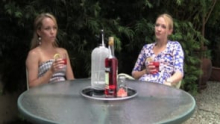Some people believe this changes everything in the quantum world, even bringing things into existence.
SHORTLISTED | Quantum Shorts 2018
Two young women are cleaning the house when they hear a knock. They want to see who it is but are afraid to open the door lest it drive them into a black hole. An existential comedy by Noemi Gunea and Grace Lambert, this film is about fear of the unknown and fear of the complicated and humbling inner workings of the cosmos. The two women try to face these fears by a sort of musical spell, which proves just as absurd as any other human attempt at battling mortality.
For those feeling brave, learn more about the quantum physics of black holes here: https://www.nature.com/news/astrophysics-fire-in-the-hole-1.12726
INTERVIEW:
Please tell us about yourself and the team that made the film
Noemi: Grace and I are performance duo Cheap Thrills. We first met doing a Masters at Central Saint Martins in London. Our individual practices were quite different but we soon grew into a two headed monster and started making live art together! We’ve had commissions from the British Museum and Royal Academy of Arts and we’ve also shown our work at the Arebyte Gallery and Battersea Arts Centre.
Grace: As for our films, we both write and perform in them, I direct, edit, do the sound design etc, Noemi produces the films and Jackson Ducasse is our in-house DOP (literally he lives in our house).
How did you come up with the idea for your film?
Grace: Our creative process is very weird, probably because we come from a performance background - so we approach making films a bit like devised theatre. Things can change quite last minute if something works out better on the day.
All of our films also revolve around our house. As we are both freelance artists who can’t afford a studio space in London, we spend a lot of time in the house. We would occasionally go out after a few days and be in absolute fear and awe of the outside world. We play these exaggerated versions of ourselves on screen, so there’ll always be a nugget of truth in everything you see from us.
What is the quantum inspiration? What makes you interested in quantum physics?
Noemi: I have a slight obsession with astrophysics, but in a way that wouldn’t be scientifically approved - I read everything as a metaphor. I feel consoled by the idea of chaos, that black matter might be the thing that holds everything together but we don’t know what it actually is. It’s scary, but it reminds me that everything man-made is just a construct that I can deconstruct should I wish to.
Grace: I’m not as obsessed as Noemi. But I do relate to existential dread particularly now that the world is crumbling around us. Our existence is miniscule in the great scheme of things. We are just cogs slowly degrading in an expanding machine of turmoil.
Please share with us an interesting detail about you how made the movie.
Grace: Our neighbours think we’re mad. We filmed ‘Knock Knock’ about 15 times because we kept getting the dance moves wrong. I think the take you’re seeing is Take 11.
What reaction do you hope for from viewers?
Noemi: We hope they’ll get some of our puns, enjoy the rhythm of it, our clowney acting and leave their existential woes behind. We want them to dance and enjoy the little things.
What is your favourite science-inspired or sci-fi movie?
Grace: Alien and the original Blade Runner are tied in first place for me.
Noemi: Under The Skin, Clockwork Orange, Tarkovsky’s Stalker, Videodrome, Akira, Alphaville, La Jetee, somebody stop me
What does being a Quantum Shorts finalist mean to you?
Noemi: It’s a bit surreal to think that the great minds of physics and mathematics are looking into our living room. We’re excited about the prize too, as we have made all of our films on no budget so any little bit helps towards the making of our next extravaganza!
Is there anything else you would like to tell us about you or your film?
Both: We plan on making at least 180 more DIY films to cover all possible film genres & more. Tune in soon for Cheapflix!
Noemi Gunea and Grace Lambert are performance duo Cheap Thrills in the United Kingdom.



